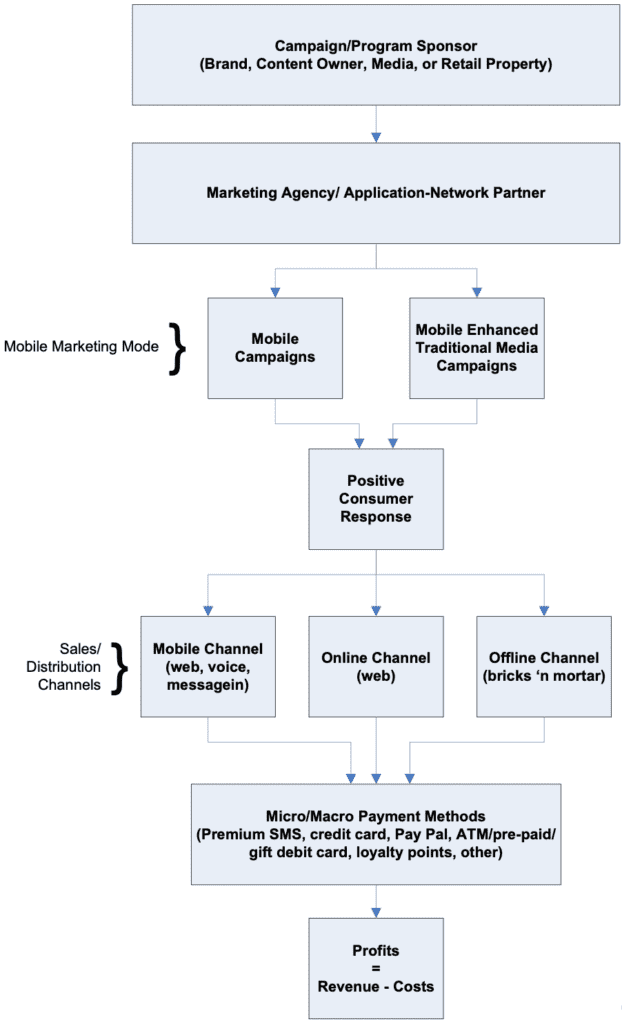Since the launch of the first SMS in 1992 and its initial commercial use for marketing purposes on/around 1997 many marketers began asking the question, “So, how can one make money with mobile marketing?” This is a very good question with many general answers; for example, it is easy to come up with an off-the-cuff response like “money is made from the sales of mobile content (ringtones, logos, images, video), premium SMS subscription (joke of the day, horoscope, sports scores, etc.), or micro-payments for physical goods and services”; however, responses like these are not actually answering the question above, rather they are answering the question “how does one make money through the mobile channel”. The mobile channel (a child born of the digital age) is used not only for distribution and commerce transactions but also for communications, entertainment, as well as marketing. Future articles can help illuminate the myriad ways of making money through the mobile channel, but this article will specifically focus on the topic of doing so through the lens of the marketing function.

In order to provide a precise answer to the question about making money with mobile marketing, one must break the question down into its parts and define what is meant by “mobile marketing” and “make money.”
Marketing is the function that helps a company tell the market what it does and explain the company’s products and services, and in this role marketing directly helps a corporation make money. But again, this is a very simplistic answer to the question of how marketing makes money, marketers develop channels, educate customers, and stimulate customer response and mobile marketing is a very effective mode of marketing. As Kavassalis comments “SMS marketing [aka mobile marketing] has interesting properties: high-speed message delivery, interactivity, great customer reach, and a response rate five times higher than direct mail” (Kavassalis et al. 2003, p56). A campaign sponsor (Brand, Content Owner, Media, or Retail Property) will work with their Marketing Agency and Mobile Applications-Network partner to run Mobile or Mobile Enhanced Traditional Media marketing campaigns to stimulate a positive consumer response (see Figure 1). For instance, respondents just learning about the product or service may be encouraged to search for additional information by contacting the company through the mobile web, instant voice response (IVR), messaging, online, or at bricks ‘n' mortar store. Once the consumer responds to a mobile program and completes the information gathering step, if they are so inclined, the next step in the consumer lifecycle is to purchase. A mobile marketing campaign can directly influence a consumer to purchase a product or service via Mobile, Online, or Offline channels, or indirectly influence future purchases through any of these channels by engendering brand trust with the consumer, as shown by Nysveen and Merisavo (Nysveen et al. 2005, Merisavo et al. 2005).
Marketing on the Revenue Side
A consumer responding to a marketing campaign or purchasing a product based on that campaign does not necessarily guarantee that a corporation will make money. A company is “making money” when it generates profits. Simply put, profits occur when revenues exceed costs. Traditionally, marketing helps in-directly on the revenue generation side by effectively communicating the value of the corporation’s products or services, pricing them in line with market demand, and making various payment methods available to facilitate a purchase, such as Premium SMS, Credit Card, Pay Pal, Debit Card, etc. Marketers do not actually produce goods or services or make the final sales. However, with mobile marketing, in some instance, the marketing campaign itself can generate revenue directly since the campaign can be an experience the users find valuable enough to pay for. Marketers can use Premium SMS, loyalty point programs, or other billing methods to charge the consumer for participating in the marketing program; they can also sell sponsorship and ad placement within the campaign experience. For example, TV viewers may be charged to vote, such as for the Big Brother in the UK, or the concert attendee may be charged to receive a ringtone and be entered to win a seat upgrade during the event. Also, marketers can sell and embed sponsorship or advertising directly into the campaign, including in the body of an SMS message, in an inline or interstitial ad on the mobile web or in an IVR based exchange, or by embedding messages within a mobile game for example. In fact, given certain situations, such as with sports-related games, consumers are demanding these ad placements since it adds a more real-world experience to the gameplay.
Marketing on the Cost Side
Within the cost component of the profit formula, mobile marketing helps by creating cost-efficient programs that establish brand awareness, generate leads, convert leads to customers, and enhance customer loyalty; mobile marketing can be very cost efficient. The ability to generate higher response rates than traditional standalone media is just one of the many unique characteristics of mobile marketing and is an important piece to the marketing effectiveness puzzle. With the increased response, the total cost per lead decreases; moreover, mobile marketing respondents tend to be more qualified given that they are actively vs. passively initiating the interaction with the brand after seeing a call-to-action, thus making for a more effective program. Finally, the variable cost for standard rate, non-premium, mobile initiatives is minuscule compared to traditional methods. In the case of high volume SMS programs delivering a message to a prospect can be as little as $0.00 per interaction with certain aggregators and channels but on average it is around $0.02~$0.05/message for moderate volumes, with commercial email services the cost per transaction can be as low as $0.01, while IVR services the cost per minute is around $0.07 and often higher, and the costs are even higher with traditional direct mail. Even Pay Per Click ads on the web are significantly higher than the mobile interaction, without the added time and location independent benefits of mobile.
In addition to recurring message traffic fees and application maintenance fees, marketers looking to use mobile should consider a few one-time costs, such as application access fees/licensing and possible professional service fees if the mobile application partner selected does not have standard templated solutions or if the requested campaign requires tailored message flow. In the short-term, there will be some additional systemic costs that marketers must consider, such as industry regulations oversight and consumer education on the use of mobile, but these will abate over time as the industry matures. The costs of mobile marketing, however, when compared to regional or nationwide traditional media campaigns are often inconsequential to the overall program budget.
A Phenomenally Valuable Channel
Mobile Marketing is one of the lowest variable cost per message channels, it is personal, and it affords the highest response rate. Moreover, we should not ignore the fact that mobile can turn any traditional channel into an interactive medium, thus enhancing the marketer's ability to establish a long lasting and fruitful relationship with customers. This relationship, when properly managed, will increase customer revenue and value to the firm over time. The use of the mobile channel for marketing is just now coming to light in the U.S. and is maturing in other areas around the world. The benefits of mobile marketing have been recognized and not missed by leading brands. In fact, Pearse reports that according to Coca-Cola’s marketing Manager James Eadie "mobile marketing could be phenomenally important when you look at the penetration of handsets and the passion the audience has for mobile…as a way of connection, it ought to be phenomenally powerful and more important than TV. So we should be spending 50% of our marketing budget within decades" (Pearse 2005).
The stage is set for marketers to significantly add value to their organization more so than at any time in history. Marketers use mobile marketing for enabling unique and engaging one-to-one relationships with their customers. To be successful with mobile, and to make money, marketers need to be creative, invest the time to learn and experiment with different mobile and traditional media mobile enhanced campaign configurations, and apply their creativity to this immensely powerful new medium.
References
Kavassalis, P., Spyropoulou, N., Drossos, D., Mitrokostas, E., Gikas, G., & Hatzistamatiou, A. (2003, Fall). Mobile Permission Marketing: Framing the Market Inquiry. International Journal of Electronic Commerce, 8(1), 55~79.
Merisavo, M., Vesanen, J., Arponen, A., & Kajalo, S. (2005). The effectiveness of targeted mobile advertising in selling mobile services: An empirical study.
Nysveen, H., Pedersen, P., Thorbjornsen, H., & Berthon, P. (2005, February). Mobilizing the Brand. Journal of Service Research, 7(3).
Pearse, Justin. 2005 Coca-Cola Believes Mobile Ads Have Potential to Upstage TV. Electronic document. NWA. http://www.nma.co.uk/Document.aspx?did=da845be8-0ac0-49d9-8232-b5632ab552b4.
Rettie, Ruth, Ursula Grandcolas, and Bethan Deakins Text Message Advertising: Dramatic Effect on Purchase Intension. Kingston University & BT.
Image by PublicDomainPictures from Pixabay

No Comments.